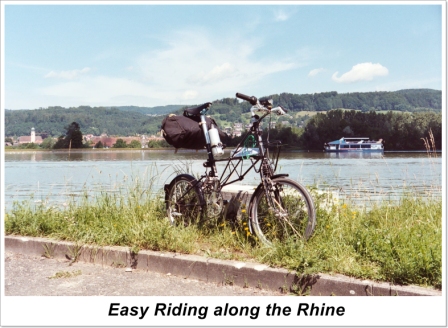
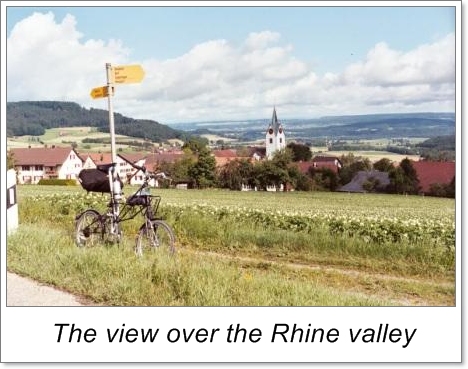
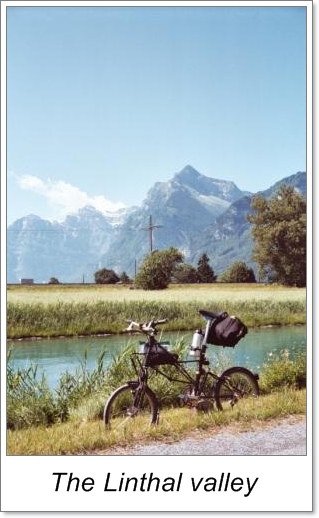
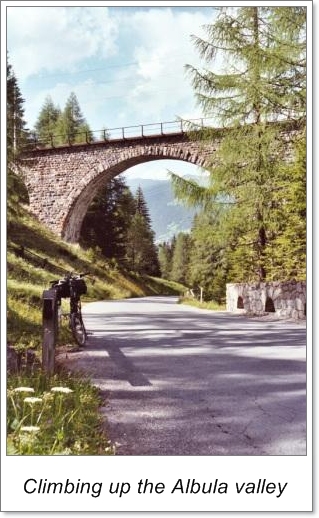
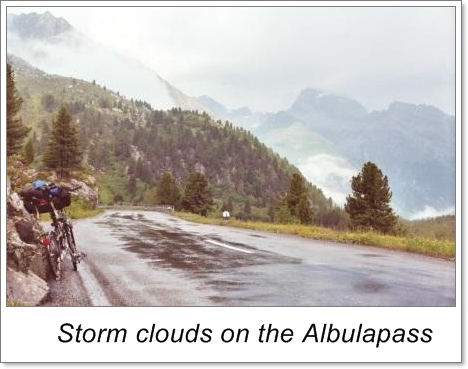
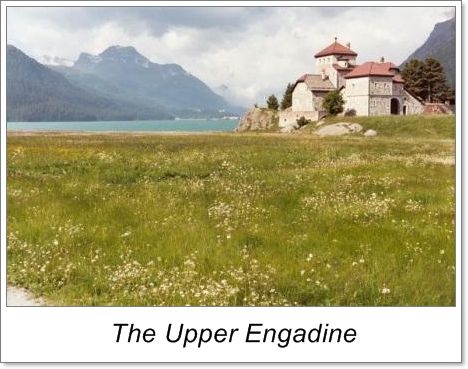
Fifty years ago, as an impressionable teenager I set off on my first trip abroad with the annual school trip. No cheap flights in those days, but a 30 hour journey by ferry and overnight train across Europe to a remote hamlet in southeast Switzerland. The week was spent exploring the area and the experience had made a lasting impression. In particular was the journey across Switzerland by local train past deep lakes and towering mountains. I had never been back to that part of Switzerland, and this year I decided to retrace the route by bike and revisit the valleys of southeast Switzerland.
I had long forgotten where we had stayed, but with the advent of the internet and on-line mapping, not only was I able to locate the hamlet, but also the hotel we had stayed at. All it needed was a couple of emails I was booked into the Preda Kulm hotel for a night. I was then able to plan my route and book the rest of my accommodation on-line.
Day 1. After flying to Basel and staying overnight with friends I headed east following the Rhine cycle path. Just outside of Basel I was caught up in a mass participation cycling event known locally as 'Slow Ups'. These take place on closed roads, including the main roads, and attract hundreds of riders, skaters and Nordic skiers using short skies with little wheels at each corner. Each village on the route has stalls with refreshments and freebies contributing to the carnival atmosphere, and attracts every type of cyclist from keen roadies to families with kids on trailer bikes. All too soon I had to leave of the Slow Up and continue along quiet lanes and paths following the Rhine for the next 80k. Although at this point I was over 400 miles from the Rhine's confluence with the North Sea, it is still an impressive river, nearly 100 meters wide in places, and at one point the Swiss had dammed the river and built a massive hydroelectric scheme. Schemes such as this provide over 60% of the country's power. Further up the river the valley narrowed to a wooded gorge with many locals enjoying their Sunday afternoon picnicing and swimming. That night I stayed at a comfortable hotel in a small village not far from the famous Rhine Falls at Schaffhausen.
Day 2. Next day I left the Rhine and headed south, climbing out of the valley into hill country and quiet farming villages complete with traditional wooden farmhouses and sheep with bells. Hay making was in full progress and there were many buzzards circling overhead seeking their prey in the freshly mown grass. It was nice to get some altitude with views back across the Rhine Valley and the Black Forest. Crossing a 600m col I descended into the next valley and the city of Winterthur. Picking up a way marked cycle route on the outskirts I was able to bypass the city following quiet tracks along the banks of the beautiful River Toss. I had planned a café stop at the next town but most places where closed with it being mid-day, so lunch was courtesy of the local Migros supermarket taken in the sun on a bench by the river. The rest of the afternoon was spent following the idyllic Toss valley on quiet roads and tracks. Crossing the head of the valley at 800m I then had a long decent following another well marked cycle route to Rapperswill on the shores of Lake Zurich. Here I stayed at the youth hostel which must rank as one of the best hostels I have ever stayed at. I had emailed the warden in advance to book a room to myself, and the next morning he rang me at home to confirm the details. The room turned out to be a south facing complete with balcony, and I could lay in bed with the balcony doors open enjoying stunning views over the lake to the mountains on the far side. After dinner that evening I was joined by a Swiss couple and their daughter. It turned out that he worked in the aviation industry and had visited British Aerospace near my home town!
Day 3. The weather forecast for the following day was for the hottest day of the year and I set off under clear blue skies. The next part of the ride followed dedicated cycle paths along the lake side and on to broad river valleys. I was accompanied by many children cycling to school, and at one point there was a cycle warden assisting the children at a road crossing. At a morning coffee I was joined by a young German cyclist from the hostel who was heading in my direction, so we cycled together to the next lake - the Wallensee. This section forms part of one of the national cycle routes and in order to create the cycle path two dedicated tunnels of about 0.5k had been blasted though the mountain, plus another section which was cantilevered out across a rock face. This must be one of the most spectacular cycle paths in Europe. I remembered travelling this section 50 years ago by train and had been impressed by the sheer cliffs at the other side of the lake, with waterfalls falling hundreds of feet into the lake. Today there were no waterfalls and the cliffs looked bone dry - a sign of the times perhaps?
After another lunch from Migros taken at a fountain in the next town, we pressed on in temperatures of 30 plus to rejoin the Rhine as it headed south to its source in the high Alps. Here Henrich turned north towards Germany and I headed south to follow the Rhine once more. As the valley narrowed the cycle path climbed up the valley sides to loop through the local vineyards and some small villages. Very pretty and scenic but by mid afternoon I was beginning flag in the heat, so I abandoned the cycle route and headed down the main road towards Chur where I had booked a hotel for the night. In retrospect riding down the main road was a mistake, although the traffic was light, there was no shade or water, but worse still no quiet village squares with fountains where I could take a rest.
The last time I had been to Chur it was a small regional capital, but now it was a large bustling city. I was hot and tired and the last place I wanted to be was in a city centre, but after a shower and an excellent meal at the local Italian restaurant I began to feel better and enjoy the charm of the old regional capital. Sitting outside the restaurant I could watch the trains sharing the main street with the traffic - there were no barriers to segregate the two, just two lines in the middle of the traffic lanes!
Day 4. Next morning I needed a quiet route out of Chur. Heading down to the station I soon spotted a cycle route sign which followed quiet roads out of town. I was then able to pick up another national cycle route that would lead me to the Albula valley. After a steep climb on forest roads which gave spectacular views over the valley, I had a long easy descent to the next village of Thusis. After a coffee in the village I had difficulty in picking up my route so I asked a group of workmen for directions using my best schoolboy German. Their reply in a thick Swiss German accent was hard to follow, but it could have been worse for I was now in Graubunden, the area of Switzerland where Romansh is spoken. This is based on Vulgar Latin, an ancient language brought back from Rome by the legionnaires. I was fortunate to get a reply in something which I could just understand. Earlier I had been hailed by some cyclists with 'Bun di', the local Romansh greeting.
I was soon back on my route and a sign by the road told me that I was about to start a long 40k climb up the valley. The first section on a main road was quite gentle through a series of tunnels. Although well lit with little traffic, two were over 1k long and the traffic noise was quite intimidating as it was amplified by the tunnel walls making it impossible to judge the distance between myself and traffic approaching from behind. By now the valley had narrowed to a gorge as the road crossed the valley on an exposed viaduct far above the river below.
After lunch at the next village the serious climbing started for the ascent of the Albula pass. Fortunately my hotel for the night at 1,700 metres was 10k below the summit. It was another hot day and the best I could manage was an average of 5mph. I would ride for an hour, gaining about a 1000ft in altitude, before needing to stop and re-hydrate. By mid afternoon, I caught an Italian cyclist on a road bike, carrying full camping gear, and having to climb out of the saddle on a 42X23 gear. I felt embarrassed riding with him on my super low granny gears.
After a tough afternoon I finally reached Preda and my hotel. Little had changed in 50 years and it was pleasing to see that there had been no commercial developments. Just the railway halt, the hotel and a few houses surrounded by rocky peaks. After a rest I dined on the terrace enjoying the views down the valley. I just needed one more fine day to get to St Moritz.
Day 5. Next morning I awoke to the sound of thunder, and though still half asleep I was aware of lightning flashes through closed eyes. Not a good day to be out on the mountain. After breakfast I joined a group of mountaineers huddled in the hotel porch watching the storm clouds rolling up the valley. They had decided to take the safe option and head down. After half an hour there was a lull in the storm and I set off up the pass. I had just emerged above the tree line when the next storm struck. Fortunately I was able to shelter under the eaves of a barn waiting for the next break. I was soon on my way again for the final stretch, arriving at the summit as another storm approached. I just had time for a photo and enjoy the satisfaction of having reached nearly 7,600ft, before sheltering in the refuge as more thunder echoed round the mountains.
The summit of the Albula Pass marks a European watershed. Behind me the steams flowed west to the Rhine and on into the North Sea. The small lake by the refuge flowed east into the Inn and Danube and eventually into the Black Sea. Two infant river systems, less than 500 meters apart, but with outfalls that spanned Europe.
Leaving the refuge in improving weather I was able to relax on the descent to the Engadine valley and the River Inn. The Engadine has a distinctive character of its own, thick walled cream stuccoed houses decorated with ornate designs; give the valley a unique atmosphere. Once down I headed for Pontresina, but on the edge of town I was caught in yet another fierce storm. This time I was able to shelter in the Bahnhof watching the hail stones bouncing off the tracks.
I spent the afternoon exploring a side valley, the Val Roseg, following a rough forestry road to a refuge just above the tree line. From here, while lingering over my coffee and Enadine Nuss Torte, I could take in the views across the moraines to the Roseg glacier cascading down from the surrounding peaks. After descending back to the Engadine it was just a short ride to St Moritz for my overnight stay at the youth hostel.
Day 6. Next day I was due to travel back to Basel, but as the fine weather had returned, I decided to head up the valley before catching the train. The Upper Engadine is one of the most scenic valleys in Switzerland, a beautiful array of forests, silvery lakes and snowy mountains. From St Moritz to Maloja at the head of the valley is just 20k and the Swiss have constructed a cycle path up the valley, set away from the roads and winding round the lakes through quiet villages, this is a route to die for. Reaching Maloja at 1815 metres I was able to look down the Poschiavo valley and across into Italy. This was the end of my ride, but not the holiday.
After retracing the route back to St Moritz I the caught the local train back to Chur. Graubunden's Rhatische Bahn is one of the most scenic networks in the world crossing the Alp's highest rail tunnel. The line gains 700m over 13k as the crow flies using hairpin bends and corkscrew tunnels, crossing the valley five times on soaring viaducts. This is an awe inspiring engineering achievement. From Chur I caught a huge double decker 10 carriage express. This must have been capable of carrying over 2000 passengers and was powered by some of the country's hydro electricity. Green transport indeed.
My last night was spent back with friends in Basel where Hans and Ilse had prepared a sumptuous end of tour supper. We talked late into the night until the wine ran out. Next day I was given a guided tour of the old town and enjoyed Kaffee und Kuchen in one of the cobbled squares. All that remained was to ride back to the airport and battle my way through security one again. Trying to explain to the X-ray machine operator that my pump did not contain exploding gas canisters was a hard task. This really was the end of the holiday.